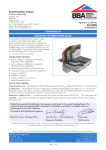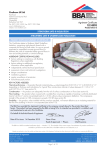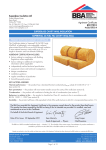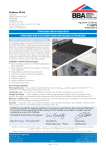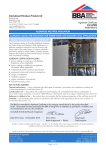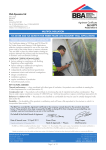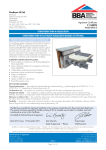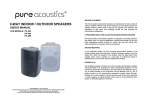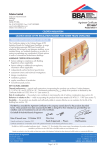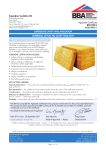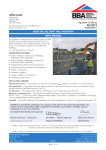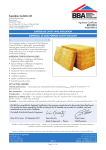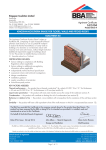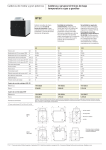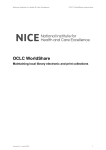Download BBA Certificate Eco-Versal in Timber Frame
Transcript
APPROVAL INSPECTION TESTING CERTIFICATION EcoTherm Insulation UK Ltd Harvey Road Burnt Mills Industrial Estate Basildon Essex SS13 1QJ Tel: 01702 520166 Fax: 01702 420636 TECHNICAL APPROVALS FOR CONSTRUCTION Agrément Certificate 99/3569 e-mail: [email protected] website: www.ecotherm.co.uk Product Sheet 3 ECOTHERM ECO-VERSAL BOARDS ECOTHERM ECO-VERSAL BOARD FOR TIMBER FRAME DWELLINGS PRODUCT SCOPE AND SUMMARY OF CERTIFICATE This Certificate relates to EcoTherm Eco-Versal Board for Timber Frame Dwellings, a rigid PIR polyurethane foam, faced on both sides with aluminium foil for use between studding in external walls of conventional timber-frame dwellings. AGRÉMENT CERTIFICATION INCLUDES: • factors relating to compliance with Building Regulations where applicable • factors relating to additional non-regulatory information where applicable • independently verified technical specification • assessment criteria and technical investigations • design considerations • installation guidance • regular surveillance of production • formal three-yearly review. KEY FACTORS ASSESSED Thermal performance — the product has a thermal conductivity (λ90/90 value) of 0.023 W·m–1·K–1 and can achieve U values of between 0.14 and 0.28 W·m–2·K–1 in example walls (see section 5). Risk of condensation — the product can contribute to minimising the risk of surface condensation (see section 6). Behaviour in relation to fire — the product can be used in suitably designed walls that satisfies the loadbearing capacity performance criterion of BS 476-21 : 1987 or BS EN 1365-1 : 1999 for the required fire-resistance period (see section 7). Durability — the product is sufficiently stable to remain effective as an insulation for the life of the building (see section 13). The BBA has awarded this Agrément Certificate to the company named above for the product described herein. This product has been assessed by the BBA as being fit for its intended use provided it is installed, used and maintained as set out in this Certificate. On behalf of the British Board of Agrément Date of First issue: 2 November 2010 Simon Wroe Head of Approvals — Physics Greg Cooper Chief Executive The BBA is a UKAS accredited certification body — Number 113. The schedule of the current scope of accreditation for product certification is available in pdf format via the UKAS link on the BBA website at www.bbacerts.co.uk Readers are advised to check the validity and latest issue number of this Agrément Certificate by either referring to the BBA website or contacting the BBA direct. British Board of Agrément Bucknalls Lane Garston, Watford Herts WD25 9BA ©2010 Page 1 of 8 tel: 01923 665300 fax: 01923 665301 e-mail: [email protected] website: www.bbacerts.co.uk Regulations In the opinion of the BBA, EcoTherm Eco-Versal Board for Timber Frame Dwellings, if used in accordance with the provisions of this Certificate, will meet or contribute to meeting the relevant requirements of the following Building Regulations: The Building Regulations 2010 (England and Wales) Requirement: B3(1) Internal fire spread (structure) Comment: Requirement: B3(4) Internal fire spread (structure) Comment: Requirement: C2(c) Resistance to moisture Comment: Requirement: L1(a)(i) Conservation of fuel and power Comment: Requirement: Regulation 7 Materials and workmanship Comment: The product is acceptable. See section 13 and the Installation part of this Certificate. Walls incorporating the product must comply with this Requirement. See section 7.1 of this Certificate. Walls incorporating the product must comply with this Requirement. See section 7.3 of this Certificate. The product can contribute to meeting this Requirement. See sections 6.1 and 6.3 of this Certificate. The product can contribute to meeting this Requirement. See sections 5.3 to 5.6 of this Certificate. The Building (Scotland) Regulations 2004 (as amended) Regulation: 8(1) Regulation: Standard: 9 2.4 2.6 3.15 6.1(b) 6.2 Carbon dioxide emissions Building insulation envelope The product is acceptable, with reference to clauses, or parts of, 6.1.6(1), 6.2.1(1), 6.2.6(1), 6.2.7(1), 6.2.9(1) and 6.2.13(1) of these Standards. See sections 5.3 to 5.6 of this Certificate. Comment: Regulation: Condensation The product can contribute to satisfying this Standard, with reference to clauses 3.15.1(1) and 3.15.5(1). See sections 6.2 and 6.3 of this Certificate. Comment: Standard: Standard: Spread to neighbouring buildings Walls incorporating the product can satisfy this Standard, with reference to clause 2.6.1(1). See sections 7.1 and 7.3 of this Certificate. Comment: Standard: Building standards — construction Cavities Walls incorporating the product must comply with this Standard, with reference to clauses 2.4.1(1)(2) and 2.4.2(1)(2). See section 7.3 of this Certificate. Comment: Standard: Fitness and durability of materials and workmanship The product satisfies the requirements of this Regulation. See section 13 and the Installation part of this Certificate. Comment: 12 Building standards — conversions All comments given for the product under Regulation 9 also apply to this Regulation, with reference to clause 0.12(1) and schedule 6(1). Comment: (1) Technical Handbook (Domestic). (2) Technical Handbook (Non-Domestic). The Building Regulations (Northern Ireland) 2000 (as amended) Regulation: B2 Fitness of materials and workmanship Comment: Regulation: C5 Condensation Comment: Regulation: E4(1) Internal fire spread — Structure Comment: Regulation: E4(4) Internal fire spread — Structure Comment: Regulation: Regulation: F2(a)(i) F3(2) Conservation measures Target carbon dioxide Emissions Rate Comment: The product is acceptable. See section 13 and the Installation part of this Certificate. Walls incorporating the product can satisfy this Regulation. See section 6.3 of this Certificate. Walls incorporating the product can satisfy this Regulation. See section 7.1 of this Certificate. Walls incorporating the product must comply with this Regulation. See section 7.3 of this Certificate. The product can contribute to a wall satisfying its target emission rate. See sections 5.3 to 5.6 of this Certificate. Construction (Design and Management) Regulations 2007 Construction (Design and Management) Regulations (Northern Ireland) 2007 Information in this Certificate may assist the client, CDM co-ordinator, designer and contractors to address their obligations under these Regulations. See section: 2 Delivery and site handling 2.3 of this Certificate. Page 2 of 8 Non-regulatory Information NHBC Standards 2010 NHBC accepts the use of EcoTherm Eco-Versal Board for Timber Frame Dwellings, when installed and used in accordance with this Certificate, in relation to NHBC Standards, Chapter 6.2 External timber framed walls. Technical Specification 1 Description 1.1 EcoTherm Eco-Versal Board for Timber Frame Dwellings consists of polyurethane (PIR) foam board, manufactured in accordance with BS EN 13165 : 2008, with a foil facing on both sides. 1.2 Boards are to be fixed between studding in a timber-frame construction. 1.3 The boards are available with the nominal properties of:(1) Length (mm) 2400 Width (mm) 1200 Thickness (mm) 25 mm to 200 mm Core density (kg·m–3) 31 Edge detail Square Compressive strength (kPa) >140 (1) Other sizes are available to order. 2 Delivery and site handling 2.1 Boards are delivered shrink-wrapped in polyethylene on non-returnable pallets. Each pack includes a label detailing the manufacturer’s trade name, product name, grade and the BBA identification mark incorporating the number of this Certificate. 2.2 Packs should be stored off the ground on a clean, level surface under cover to protect the boards from: • moisture • mechanical damage • direct sunlight or elevated temperatures • open flame or other ignition sources • solvents. 2.3 As the boards are large they should be handled with care, particularly in a windy situation. Assessment and Technical Investigations The following is a summary of the assessment and technical investigations carried out on EcoTherm Eco-Versal Board for Timber Frame Dwellings. Design Considerations 3 General 3.1 EcoTherm Eco-Versal Board for Timber Frame Dwellings is effective in reducing the thermal transmittance (U value) of external walls of timber-frame dwellings. It is essential that such walls are designed and constructed to incorporate the normal precautions against moisture ingress, including a breather membrane over the timber sheathing. 3.2 New buildings subject to the national Building Regulations should be designed in accordance with the relevant recommendations of BS EN 1995-1-1 : 2004 and the National Annex. 3.3 Constructions incorporating a masonry outer leaf (includes masonry units and natural stone blocks) should be in accordance with BS EN 1996-2 : 2006 and the National Annex. The designed residual cavity width should be 50 mm and at no point less than 35 mm wide(1). (1) A residual cavity, nominally 50 mm wide, will be required by the NHBC where normal standards of tolerance and workmanship are adopted. 3.4 It is recommended that services which penetrate the dry lining, eg light switches, power outlets, are kept to a minimum to limit damage to vapour checks. In addition, any penetrations should be either enclosed in plasterboard or stone mineral wool or suitably tested proprietary fire-rated systems to preserve the fire resistance of the wall. 3.5 This application requires the specifying of a vapour control layer (VCL) behind the internal finish. The VCL should take the form of 500 gauge polythene or plasterboard backed with a vapour control membrane (or similar). 3.6 Installation must not be carried out until the moisture content of the timber frame is less than 20%. Page 3 of 8 4 Practicability of installation The boards are designed to be installed by a competent general builder, or a contractor, experienced with this type of product. 5 Thermal performance 5.1 Calculations of thermal transmittance (U value) should be carried out in accordance with BS EN ISO 6946 : 2007 and BRE report (BR 443 : 2006) Conventions for U-value calculations using the declared thermal conductivity (λ90/90 value) of 0.023 W·m–1·K–1 and an emissivity value of 0.05 for the foil facer. 5.2 The U value of a completed wall will depend on the selected insulation thickness and the insulation value of the masonry and the internal finish. Calculated U values for example constructions are given in Table 1. Table 1 Example wall U values (W·m–2·K–1) Insulation thickness (mm) Stud depth (mm) 75 U value 89 0.28 100 140 0.22 120 140 0.19 150 200 0.16 170 200 0.14 200 200 0.14 Note: Example timber-frame construction comprising 102 mm brick leaf, 50 mm unventilated cavity, breathable membrane, 9 mm OSB board, 15% timber studs, 12.5 mm plasterboard. 5.3 When considering insulation requirements, designers should refer to the detailed guidance contained in the documents supporting the national Building Regulations. The U values shown in Table 1 indicate that the product can enable, or contribute to enable, a wall to achieve typical design U values referred to in those supporting documents (see Tables 2 to 4). Table 2 Mean design wall U values — England and Wales (1) Construction U value (W·m–2·K–1) Notional non-domestic building 0.26 Existing building – new and replaced wall 0.28 Dwelling new-build limit 0.30 Existing building – renovated or retained walls 0.30 Notional dwelling 0.35 Non-domestic new-build limit 0.35 (1) Flexible approaches on existing buildings are given in the Approved Documents. Table 3 Mean design wall U values — Scotland (1) Construction U value (W·m–2·K–1) Notional dwelling 0.19 New dwelling simplified method 0.19 Conversion unheated building (into dwellings) 0.19 Extension to dwelling 0.19 Alterations and reconstructions to a dwelling 0.22 Stand-alone building < 50 m to a dwelling 0.22 New non-dwellings limit for shell and fit out 0.23 2 New dwelling limit 0.25 Conversion of unheated building 0.25 Non-domestic extension, alterations and reconstructions 0.25 New non-domestic limit 0.27 Conversion of heated building 0.30 Notional non-dwelling 0.30 (1) Flexible approaches on existing buildings are given in the Technical Handbooks. Page 4 of 8 Table 4 Mean design wall U values — Northern Ireland (1) Construction U value (W·m–2·K–1) Existing building – new wall Notional dwelling Notional non-domestic building Building new-build limit Existing building – replaced, renovated and retained wall 0.30 0.35 0.35 0.35 0.35 (1) Flexible approaches on existing buildings are given in the Technical Booklets. New buildings 5.4 Walls with U values lower than (or the same as, for dwellings in Scotland) the relevant ‘notional’ value specified in Table 2, 3 and 4 will contribute to a building meeting its Target Emission Rate. Walls with higher U values will require additional energy saving measures in the building envelope and/or services. 5.5 The product can maintain, or contribute to maintaining, continuity of thermal insulation at junctions between elements. For Accredited Construction Details the corresponding psi values in BRE Information Paper IP 1/06 Assessing the effects of thermal bridging at junctions and around openings, Table 3 may be used in carbon emission calculations in Scotland and Northern Ireland. Detailed guidance for other junctions and on limiting heat loss by air infiltration can be found in: England and Wales — Approved Documents to Part L and for new thermal elements to existing buildings, Accredited Construction Details (version 1.0). See also SAP 2009 Appendix K and the iSBEM User Manual for new-build. Scotland — Accredited Construction Details (Scotland) Northern Ireland — Accredited Construction Details (version 1.0). Existing buildings 5.6 For existing buildings, such as extensions or conversions, walls will be acceptable where they do not exceed the relevant U value in Tables 2, 3 and 4 and junctions and openings comply with section 5.5. 6 Risk of condensation Surface condensation 6.1 Walls will limit the risk of surface condensation adequately when the thermal transmittance (U value) does not exceed 0.7 W·m–2·K–1 at any point, and the junctions with other elements are designed in accordance with section 5.5. 6.2 Walls will adequately limit the risk of surface condensation when the thermal transmittance (U value) does not exceed 1.2 W·m–2·K–1 at any point. Guidance may be obtained from Section 8 of BS 5250 : 2002 and BRE report (BR 262 : 2002) Thermal insulation: avoiding risks. Interstitial condensation 6.3 Walls incorporating the product will adequately limit the risk of interstitial condensation when they are designed and constructed in accordance with BS 5250 : 2002 (Section 8 and Annex D). 6.4 Both foil facings have a water vapour resistance exceeding 70 MN·s·g–1 and the insulation core has a water vapour resistivity of 300 MN·s·g–1·m–1. When all joints between boards are taped for over stud applications, the product can provide significant resistance to water vapour transmission. 6.5 If the product is to be used in the external walls of rooms expected to have high humidity, care must be taken to provide adequate permanent ventilation to avoid possible problems from the formation of interstitial condensation in the wall. 7 Behaviour in relation to fire 7.1 The product can be added to the void between studwork in any loadbearing, timber-framed inner leaf to a double leaf wall system providing that the existing inner leaf system is lined with gypsum plasterboard with a fire performance of A2-s3,d2 or better. This satisfies the loadbearing capacity performance criterion of BS 476-21 : 1987 or BS EN 1365-1 : 1999 for the required fire-resistance period. However, this does not apply where the tested construction includes mineral wool, rockwool or similar insulation. 7.2 The suitability of constructions other than those described in section 7.1 should be demonstrated by an appropriate test or assessment. 7.3 Cavity barriers must be provided to comply with: England and Wales — Approved Document B, Section 6 Scotland — Mandatory Standard 2.4, clauses 2.4.1, 2.4.2 and 2.4.7 Northern Ireland — Technical Booklet E, paragraphs 3.35 to 3.38. 7.4 When classified in accordance to BS EN 13501-2 : 2007 the product achieved a class E rating. Page 5 of 8 8 Proximity of flues and appliances When installing the product in close proximity to certain flue pipes and/or heat-producing appliances, the following provisions to the national Building Regulations are acceptable: England and Wales — Approved Document J Scotland — Mandatory Standard 3.19, clauses 3.19.1(1) to 3.19.9(1) (1) Technical Handbook (Domestic). Northern Ireland — Technical Booklet L. 9 Weathertightness 9.1 Constructions incorporating the product and built in accordance with section 3.3 will resist the transfer of precipitation to the inner leaf and satisfy the national Building Regulations: England and Wales — Requirement C2(a)(b)(c) Scotland — Mandatory Standard 3.10, clause 3.10.5(1) (1) Technical Handbook (Domestic). Northern Ireland — Regulation C4. 9.2 In all situations it is particularly important to ensure during installation that: • wall ties and fixings are installed correctly and are thoroughly clean • excess mortar is cleaned from the cavity face of the brick leaf and any debris removed from the cavity • installation is carried out to the highest level on each wall or the top edge of the insulation is protected by a cavity tray • a cavity tray, stop ends and weepholes, must be provided at lintel level. 10 De-rating of electrical cables In some cases it may be necessary to de-rate electrical cables buried in insulation as for other insulation products. BS 7671 : 2008, indicates that where wiring is completely surrounded by insulation, it may need to be de-rated to as low as half its free air current carrying capacity. Guidance should be sought from a qualified electrician. 11 Infestation Use of the product does not in itself promote infestation and there is no food value in the materials used. The creation of voids within the structure, ie gaps between the wall lining and the boards may provide habitation for insects or vermin in areas already infested. Wherever possible care should be taken to ensure that all voids are sealed, as any infestation may be difficult to eradicate retrospectively. 12 Maintenance As the insulation component of the product is confined behind the wall lining and it has suitable durability (see section 13), maintenance is not required. 13 Durability The boards are rot proof, stable and will have a life equivalent to that of the wall structure in which they are incorporated. Installation 14 General 14.1 Installation of EcoTherm Eco-Versal Board for Timber Frame Dwellings must be in accordance with the relevant Clauses of BS EN 1996-1-1: 2005, the National Annex and the Certificate holder’s instructions. Construction installation details are given in Figure 1. Page 6 of 8 Figure 1 Installation details 22 mm x 25 mm batten plasterboard VCL stud breather membrane EcoTherm Eco-Versal Board for Timber Frame 9 mm OSB sheathing 14.2 The boards are light to handle and easily cut, but care must be taken to prevent damage particularly at edges. 14.3 Damaged boards should not be used; small areas of damaged faces may be repaired with self-adhesive aluminium foil tape. 14.4 Boards should be cut to fit tightly between the timber studding and positioned against the inner face of the sheathing board. Any edge gaps should be filled with expanding insulation foam. The insulation should be held in place by nails or timber battens to the warm side of the insulation. 14.5 The void created by space between the inner surface of the product and the dry lining can be utilised as an insulated service duct. 14.6 Before applying the internal finish a sealed polythene vapour control layer of minimum thickness 0.125 mm (500 gauge) with lapped and sealed joints is placed over the stud face. Technical Investigations 15 Investigations Results of test data on EcoTherm Eco-Versal Board for Timber Frame Dwellings were assessed in relation to: • water vapour resistance • density • thermal conductivity • compressive strength • dimensional accuracy • dimensional stability with temperature and humidity • condensation risk. Bibliography BS 476-21 : 1987 Fire tests on building materials and structures — Methods for determination of the fire resistance of loadbearing elements of construction BS 5250 : 2002 Code of practice for control of condensation in buildings BS 7671 : 2001 Requirements for electrical installations. IEE Wiring Regulations. Sixteenth Edition BS EN 1365-1 : 1999 Fire resistance tests for loadbearing elements — Walls BS EN 1995-1-1 : 2004 Eurocode 5 : Design of timber structures — General — Common rules and rules for buildings NA to BS EN 1995-1-1 : 2004 UK National Annex to Eurocode 5 : Design of timber structures — General — Common rules and rules for buildings BS EN 1996-1-1 : 2005 Eurocode 6 : Design of masonry structures — General rules for reinforced and unreinforced masonry structures NA to BS EN 1996-1-1 : 2005 UK National Annex to Eurocode 6 : Design of masonry structures — General rules for reinforced and unreinforced masonry structures BS EN 1996-2 : 2006 Eurocode 6 : Design of masonry structures — Design considerations, selection of materials and execution of masonry NA to BS EN 1996-2 : 2006 UK National Annex to Eurocode 6 : Design of masonry structures — Design considerations, selection of materials and execution of masonry BS EN 13165 : 2008 Thermal insulation products for buildings — Factory made rigid polyurethane foam (PUR) products — Specification BS EN 13501-2 : 2007 Fire classification of construction products and building elements. Classification using data from fire resistance tests, excluding ventilation services. BS EN ISO 6946 : 2007 Building components and building elements — Thermal resistance and thermal transmittance — Calculation method Page 7 of 8 Conditions of Certification 16 Conditions 16.1 This Certificate: • relates only to the product/system that is named and described on the front page • is granted only to the company, firm or person named on the front page — no other company, firm or person may hold or claim any entitlement to this Certificate • is valid only within the UK • has to be read, considered and used as a whole document — it may be misleading and will be incomplete to be selective • is copyright of the BBA • is subject to English law. 16.2 Publications and documents referred to in this Certificate are those that the BBA deems to be relevant at the date of issue or re-issue of this Certificate and include any: Act of Parliament; Statutory Instrument; Directive; Regulation; British, European or International Standard; Code of Practice; manufacturers’ instructions; or any other publication or document similar or related to the aforementioned. 16.3 This Certificate will remain valid for an unlimited period provided that the product/system and the manufacture and/or fabrication including all related and relevant processes thereof: • are maintained at or above the levels which have been assessed and found to be satisfactory by the BBA • continue to be checked as and when deemed appropriate by the BBA under arrangements that it will determine • are reviewed by the BBA as and when it considers appropriate. 16.4 In granting this Certificate, the BBA is not responsible for: • the presence or absence of any patent, intellectual property or similar rights subsisting in the product/system or any other product/system • the right of the Certificate holder to manufacture, supply, install, maintain or market the product/system • individual installations of the product/system, including the nature, design, methods and workmanship of or related to the installation • the actual works in which the product/system is installed, used and maintained, including the nature, design, methods and workmanship of such works. 16.5 Any information relating to the manufacture, supply, installation, use and maintenance of this product/system which is contained or referred to in this Certificate is the minimum required to be met when the product/system is manufactured, supplied, installed, used and maintained. It does not purport in any way to restate the requirements of the Health & Safety at Work etc Act 1974, or of any other statutory, common law or other duty which may exist at the date of this Certificate; nor is conformity with such information to be taken as satisfying the requirements of the 1974 Act or of any statutory, common law or other duty of care. In granting this Certificate, the BBA does not accept responsibility to any person or body for any loss or damage, including personal injury, arising as a direct or indirect result of the manufacture, supply, installation, use and maintenance of this product/system. British Board of Agrément Bucknalls Lane Garston, Watford Herts WD25 9BA ©2010 Page 8 of 8 tel: 01923 665300 fax: 01923 665301 e-mail: [email protected] website: www.bbacerts.co.uk








